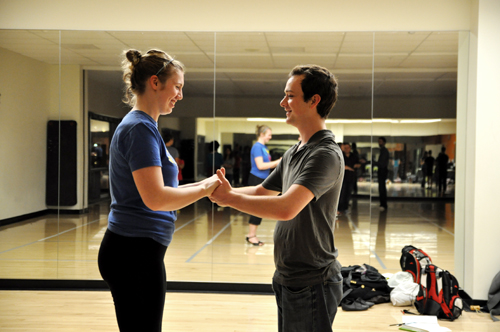
Movies commonly portray tango as an over-the-top dance style complete with roses—but it doesn’t have to be that way. Portland State’s tango club features Argentinean tango, which is considered a social dance and is much more personal and subtle. The club offers a way for newcomers or experienced tango dancers to have instruction and practice time with the dance.
The club’s two teachers are Mike McCarrel and Maricela McKay. McCarrel has been dancing tango for about seven years, and McKay about four. They both said they enjoy the intensity and beauty of the dance style.
“It’s beautiful, it’s a whole culture and it is unique,” McKay said. “It is fun the way an intense conversation is fun. It may take some time to see the beauty, but it’s there, and when you are in it, you are mesmerized. It’s like the rest of the room isn’t even there. It is as much about the dancers as it is about the people watching…It is a subtle dance form—fun and rewarding.”
The PSU tango club varies in size, and the teachers encourage new dancers to come try it out no matter what level of knowledge they have. McCarrel said that it is a unique style of dance and that the music is something people don’t hear every day, which makes it exciting.
“The music is a little bit different,” McCarrel said. “There are no drums in tango, and it’s kind of like Big Band music in that it was written for dancers, written for people to dance to the music. There’s less tempo changes, but at the same time it was a very popular music of the time, and we use only the very high quality pieces out of the hundreds that were written in Buenos Aires.”
Tango is a combination of fluidity and preciseness. McKay said it is a dance that emphasizes the connection between partners and all the moves that mold that connection. Katie Quick, the club’s president, also talked about how the partner connection is crucial to understanding the dance.
Quick said that factors such as the song playing, the ability of your partner and the amount of people in the audience all change and affect the dance that is performed.
“Tango is truly unlike any other dance,” Quick said. “Almost every dance out there has a basic meaning. You can count out the moves and come up with a choreographed pattern. There is no such thing in tango. It is based purely upon the connection to the other person, as well as the comfort and dancing ability of your partner.”
Quick has only been dancing tango for a year and a half, and she discovered the dance through the PSU club. She said that although the dance style was tough to get a grasp on at first, the openness and friendliness of the teachers were outstanding and made her come back wanting to learn more.
“Tango can be difficult for beginners because of the very nature of the dance,” she said. “Many people are phased by the fact that you dance chest to chest with your partner—we try to pop those space bubbles as soon as possible.”
Outside of the club, there are many ways for those interested to get involved in the dance style. Portlandtango.com lists upcoming performances, classes and teachers in the area.
One of the featured upcoming events on the site is the Valentango, which will be held Feb. 15–20. It is held at the DoubleTree hotel in Northeast, near the Lloyd Center, and will feature classes, performances, music and everything tango. McKay, McCarrel and Quick all encourage anyone interested to come to the event, regardless of the level of expertise.
“I had gone with a friend and wasn’t immediately hooked by the dance itself, but rather by the friendly atmosphere and the welcoming people who ran the club,” Quick said. “I came back the following week for my first lesson, and from that point on, I knew that I wanted to dance tango.”
Students do not need to bring a partner. The club is held every Tuesday evening from 8 to 11 p.m. in the large studio on the fourth floor of the Rec Center.
